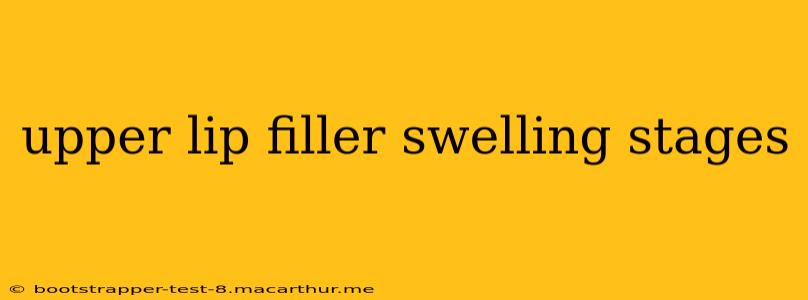Getting lip fillers is a popular cosmetic procedure, offering a subtle or dramatic enhancement depending on your desired outcome. However, swelling is a common side effect, and understanding the stages of swelling after an upper lip filler treatment can help manage expectations and ensure a smooth recovery. This guide will detail the typical swelling timeline, address common concerns, and provide helpful tips for managing post-procedure swelling.
What are the Stages of Swelling After Upper Lip Filler?
Swelling after upper lip filler is a natural response to the injection process. The severity and duration vary from person to person, depending on factors like the amount of filler used, the injection technique, and individual healing responses. Generally, you can expect to see several distinct stages:
Stage 1: Immediate Swelling (0-24 hours): Immediately following the procedure, you might experience some mild to moderate swelling. This is the body's initial reaction to the injection and is usually considered normal. The area may feel slightly tender or bruised.
Stage 2: Peak Swelling (24-72 hours): Within 24-72 hours, the swelling typically reaches its peak. This is the most noticeable stage, and your lips might appear significantly larger than expected. This stage is temporary and part of the natural healing process.
Stage 3: Gradual Reduction (3-7 days): After the peak swelling subsides, you'll notice a gradual reduction in swelling over the next 3-7 days. The swelling will decrease daily, revealing the final, more natural-looking result.
Stage 4: Final Result (7-14 days): While most of the swelling resolves within a week, it can take up to two weeks for the final result to become fully apparent. Any remaining swelling should be minimal by this point. Remember that the filler itself continues to integrate into your tissue for several weeks, leading to a subtle refinement of the shape and volume during this time.
How Long Does Upper Lip Filler Swelling Last?
The duration of swelling varies, but generally, most of the significant swelling resolves within 7 days. However, some residual swelling might persist for up to two weeks before completely disappearing. Factors influencing the duration include:
- Amount of filler injected: Larger amounts of filler naturally lead to more swelling.
- Injection technique: Different injection techniques can affect the degree of swelling. Your injector will choose the most suitable technique based on your needs.
- Individual healing response: Each individual heals at a different pace.
What Can I Do to Reduce Upper Lip Filler Swelling?
Several strategies can help minimize swelling and discomfort:
- Ice Packs: Apply ice packs wrapped in a thin cloth to the area for 15-20 minutes at a time, several times a day, especially during the first 24-48 hours. This constricts blood vessels, reducing swelling.
- Elevation: Keep your head elevated while sleeping to reduce fluid retention.
- Avoid strenuous activity: Avoid activities that increase blood flow to your face, such as intense exercise, for the first few days.
- Limit alcohol and sodium intake: Both alcohol and sodium can contribute to fluid retention, exacerbating swelling.
- Follow your injector's instructions: Always diligently follow the post-procedure care instructions given by your medical professional.
Is Swelling After Upper Lip Filler Normal?
Yes, swelling is a normal and expected side effect of upper lip filler injections. It’s a sign that your body is responding to the treatment. While some minor bruising or discomfort is also common, excessive swelling, severe pain, or other concerning symptoms should be reported to your healthcare provider immediately.
Why is My Upper Lip Still Swollen After a Week?
If significant swelling persists after a week, it's best to contact your injector. While some residual swelling is normal, prolonged or excessive swelling might indicate a complication that requires attention. Your injector can assess the situation and determine the appropriate course of action.
What if I'm Still Experiencing Swelling After Two Weeks?
If swelling continues after two weeks, it's crucial to schedule a follow-up appointment with your injector. They can evaluate the situation and address any underlying concerns, ensuring your safety and satisfaction with the results.
By understanding the typical swelling stages and taking proactive steps to minimize discomfort, you can have a more positive experience with upper lip filler treatments and enjoy the desired aesthetic improvements. Remember, always consult a qualified and experienced medical professional for any cosmetic procedure.
